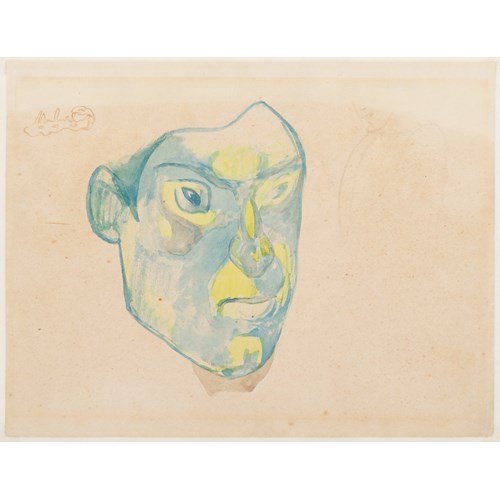Giovanni Benedetto CASTIGLIONE
The Nativity or The Angel Instructing Joseph to Flee with his Family to Egypt
Medium Brush and brown ink and ochre wash, with white heightening, and touches of pink, blue and reddish-brown oil paint
Dimension 44 x 32.4 cm (17³/₈ x 12³/₄ inches)
Despite their seemingly unfinished appearance, Castiglione’s brush drawings seem to have been conceived and made as independent works for sale, rather than preparatory studies or working drawings, although their compositions are sometimes replicated in his pictures. They are usually difficult to date, since they can only rarely be directly associated with paintings, but the earliest are thought to date from the 1630s, with the majority produced after the middle of the 1640s. In general, it appears that earlier in his career Castiglione’s brush drawings in oil are handled in a looser, more fluid manner than his later studies, which have a more elaborate, finished quality. Blunt has noted of such brush drawings that ‘The pigment used varies at different periods from a yellowish or even greenish brown, to a fairly strong orange, and in the late drawings to a dull crimson. In the early sketches the whole effect is obtained by sharp, clearly defined brush strokes, but in the later works semi-transparent washes are used, and in some cases the sky and parts of the figures are finished with ordinary oil paint mixed in the normal way with a binding medium. This method had great advantages for an artist of Castiglione’s particular temperament. It is a rapid and fluent technique which enables the painter – one cannot really say draughtsman in this context – to obtain with a few strokes a striking, if sometimes rather superficial effect. It is well suited to the lively baroque form of composition which Castiglione used, particularly in his later period. It offers no opportunity for the careful, thoughtful formulation employed by a Poussin, but such a conception of art was in any case entirely foreign to Castiglione.’
Castiglione was particularly fond of the theme of the Nativity or Adoration of the Shepherds, which was repeated with variations in a number of brush drawings, as well as in monotypes. This fine brush drawing is likely to date from the last years of the artist's career. As has been noted, ‘By the late 1650s Castiglione’s working procedure was entirely internalised, and increasingly his expressiveness outweighed the descriptive function of the drawings…he applied successive layers of drier and more opaque red-brown earth colours over initial markings of liquid yellowish-brown stains, then set off the composition with accents of pale blue-greys and off-whites, sometimes even violets, and a smattering of illegible stray lines to hint at unresolved components of the composition. In their unfinished painterly state, these drawings appeal strongly to our modernist sensibilities, revealing much of his creative process as he built up the image…Castiglione’s prodigious creative capacities remained undimmed even at the end of his artistic journey.’
Although a late work by the artist, and probably datable to the late 1650s or early 1660s, it may be noted of the present sheet that the pose of the Virgin and Child is reminiscent of the same figure group in Castiglione’s monumental altarpiece of The Adoration of the Shepherds, signed and dated 1645, in the church of San Luca in Genoa, which is one of the artist’s earliest dated works, and among his most celebrated. An almost identical figure of the reclining Saint Joseph also appears in a brush drawing of The Angel Appearing to Saint Joseph in the Royal Collection at Windsor Castle.
An analogous, albeit somewhat smaller, brush drawing of The Penitence of Saint Peter by Castiglione - which was, like the present sheet, at one time in the notable collection of the American banker and philanthropist Jules Semon Bache (1861-1944) - was on the art market in New York in 1999. Stylistic comparisons may also be made with a brush drawing of The Adoration of the Shepherds, formerly in the Mariette collection and today in the Hermitage in St. Petersburg and another of Angels Adoring the Virgin and Child in the Nationalmuseum in Stockholm.
Made up at the upper left corner and a small made-up area at the lower centre.
A repaired tear in the upper left quadrant and another repaired tear extending diagonally across the sheet.
Laid down.
Medium: Brush and brown ink and ochre wash, with white heightening, and touches of pink, blue and reddish-brown oil paint
Dimension: 44 x 32.4 cm (17³/₈ x 12³/₄ inches)
Provenance: Jules S. Bache, New York
Anonymous sale, London, Sotheby’s, 2 July 1997, lot 11 Galerie de Bayser, Paris, in 1998
Jean Bonna, Geneva.
Literature: Nathalie Strasser, Carnets d’études 4: Dessins italiens de la collection Jean Bonna, exhibition catalogue, Paris, 2006, pp.46-47, no.24; Nathalie Strasser, Dessins italiens de la Renaissance au siècle des lumières: Collection Jean Bonna, Geneva, 2010, pp.220-221, no.97 (where dated c.1650).
Exhibition: Paris, École Nationale Supérieure des Beaux-arts, Dessins italiens de la collection Jean Bonna, 2006, no.24.
Plus d'œuvres d'art de la Galerie









